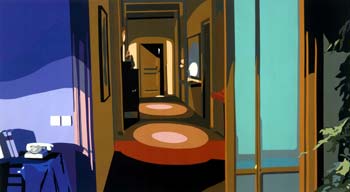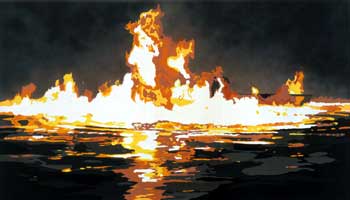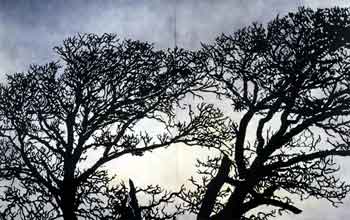
Inside Out, 2004.
Colored paper collage, gouache, airbrush on paper,
58" x 98 1/2".

Apprehensiion, 2004.
Colored paper collage, gouache, airbrush on paper,
26 1/4" x 47 3/4".

Spectacle (1), 2004.
Colored paper collage, gouache, airbrush on paper,
58" x 100 1/2".

This is Nowhere, 2004.
Colored paper collage, gouache, airbrush on paper,
94" x 147 1/4".
One work seems removed from the others. Inside Out shows what looks like an old medieval, Renaissance, or even Middle Eastern town on a hill, with archways, steps, and towers clustered together as schematically and suggestively as are the trees and elongated, portal-like arches in the foreground. There are many ways in but nowhere really to go. It is a fantasy, a made-up place, outlined against a glowing sky, with many entrances and no interiors. Ultimately, it is just a drawing of some place in the mind, a historically determined myth--certainly nowhere to live--though there is nothing coy about its mythologizing.
Scenes in some of the other works are more familiar, and some are places in which to live, house interiors that are not distant at all like the town on the hill, but rather, unavoidably close-up and rich in human detail--mirrors, wallpaper, rugs, chairs, doors, clothes draped from a sink--but not in human beings. They are sort of like Matisse's interiors in the way that everything is flattened out against the flatness of the picture plane so that we are confronted with maps of space in which each object is transmuted into a unit of the picture plane's organization. And every such unit is made up of much smaller units of colored paper (also like Matisse, in his late cutouts), rather than brushstrokes, contributing finally to a compaction of several levels of fabrication comprising and informing the illusion: the cutting of the paper into shapes; the combining and pasting of the paper shapes into larger shapes; the focus on scenes, such as domestic interiors, that are themselves fabrications; and the derivation of some such scenes, apparently, from movie sets, which are, of course, deliberate fabrications for the purpose of staging fabricated narratives.
The intensity of this reinforced fabrication forces itself on the viewer in the way that a movie does, and, indeed, the pictures seem to be the scale and dimensions of a movie screen. One's own assumptions become part of that fabricated world and are understood to be just as fictitious, or perhaps the fiction is accepted as real. In Apprehension, one accepts the space as real, with its hall in a perspective leading back to a closed door. And then it turns into an interlocking pattern of color shapes--green rectangles, orange and red ovals, blue rectangles with curved edges--and one becomes aware that that this is only small part of a much larger pattern, that there are other rooms off to the side that can't be seen, and, of course, much more outside that is totally unknown, except for its light in the shape of windows.
What is outside the window might be the fire represented in Spectacle (1) and Spectacle (2), the kind of disaster that more than likely occupies a special place in the consciousness of Californians, as we are all occupied by disaster in one way or another. The colored paper collage forms even more readily into flames than it does into walls, doorways, and furniture. There is little distance between that wilder, elemental phenomenon--fire burning on water into the air--and the more ordered one of the house interior. This is Nowhere is the largest picture in the show and has the greatest ratio of height to width, which creates the effect of expanding upward beyond the other formats. Its space and imagery are encompassing but anomalous, ominous but not threatening like the fire, inviting but not a place to enter into like the interiors. There is no ground plane as in the others but just the upper parts of two enormous trees rising against a shifting, brightly darkening sky. As with Inside Out, the viewer's eye moves upward and inward rather than being detained in the foreground. In a complicated web, the branches of the two trees stand out against the dramatic changes in the sky rather than thrusting forward to confine and determine the viewer's perception of space. More than ever, we are in a place that is completely unknown to us in the context of being known.
Donald Goddard © 2004